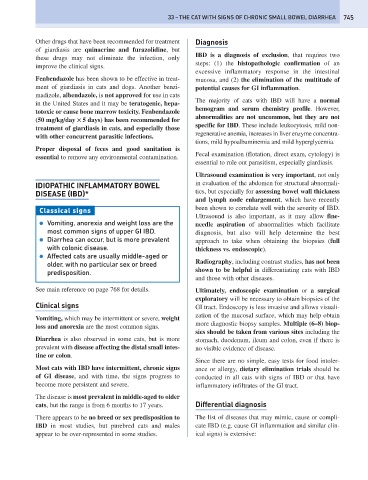Page 753 - Problem-Based Feline Medicine
P. 753
33 – THE CAT WITH SIGNS OF CHRONIC SMALL BOWEL DIARRHEA 745
Other drugs that have been recommended for treatment Diagnosis
of giardiasis are quinacrine and furazolidine, but
IBD is a diagnosis of exclusion, that requires two
these drugs may not eliminate the infection, only
steps: (1) the histopathologic confirmation of an
improve the clinical signs.
excessive inflammatory response in the intestinal
Fenbendazole has been shown to be effective in treat- mucosa, and (2) the elimination of the multitude of
ment of giardiasis in cats and dogs. Another benzi- potential causes for GI inflammation.
madizole, albendazole, is not approved for use in cats
The majority of cats with IBD will have a normal
in the United States and it may be teratogenic, hepa-
hemogram and serum chemistry profile. However,
totoxic or cause bone marrow toxicity. Fenbendazole
abnormalities are not uncommon, but they are not
(50 mg/kg/day × 5 days) has been recommended for
specific for IBD. These include leukocytosis, mild non-
treatment of giardiasis in cats, and especially those
regenerative anemia, increases in liver enzyme concentra-
with other concurrent parasitic infections.
tions, mild hypoalbuminemia and mild hyperglycemia.
Proper disposal of feces and good sanitation is
Fecal examination (flotation, direct exam, cytology) is
essential to remove any environmental contamination.
essential to rule out parasitism, especially giardiasis.
Ultrasound examination is very important, not only
IDIOPATHIC INFLAMMATORY BOWEL in evaluation of the abdomen for structural abnormali-
DISEASE (IBD)* ties, but especially for assessing bowel wall thickness
and lymph node enlargement, which have recently
been shown to correlate well with the severity of IBD.
Classical signs
Ultrasound is also important, as it may allow fine-
● Vomiting, anorexia and weight loss are the needle aspiration of abnormalities which facilitate
most common signs of upper GI IBD. diagnosis, but also will help determine the best
● Diarrhea can occur, but is more prevalent approach to take when obtaining the biopsies (full
with colonic disease. thickness vs. endoscopic).
● Affected cats are usually middle-aged or
Radiography, including contrast studies, has not been
older, with no particular sex or breed
shown to be helpful in differentiating cats with IBD
predisposition.
and those with other diseases.
See main reference on page 768 for details. Ultimately, endoscopic examination or a surgical
exploratory will be necessary to obtain biopsies of the
Clinical signs GI tract. Endoscopy is less invasive and allows visuali-
zation of the mucosal surface, which may help obtain
Vomiting, which may be intermittent or severe, weight
more diagnostic biopsy samples. Multiple (6–8) biop-
loss and anorexia are the most common signs.
sies should be taken from various sites including the
Diarrhea is also observed in some cats, but is more stomach, duodenum, ileum and colon, even if there is
prevalent with disease affecting the distal small intes- no visible evidence of disease.
tine or colon.
Since there are no simple, easy tests for food intoler-
Most cats with IBD have intermittent, chronic signs ance or allergy, dietary elimination trials should be
of GI disease, and with time, the signs progress to conducted in all cats with signs of IBD or that have
become more persistent and severe. inflammatory infiltrates of the GI tract.
The disease is most prevalent in middle-aged to older
cats, but the range is from 6 months to 17 years. Differential diagnosis
There appears to be no breed or sex predisposition to The list of diseases that may mimic, cause or compli-
IBD in most studies, but purebred cats and males cate IBD (e.g. cause GI inflammation and similar clin-
appear to be over-represented in some studies. ical signs) is extensive:

